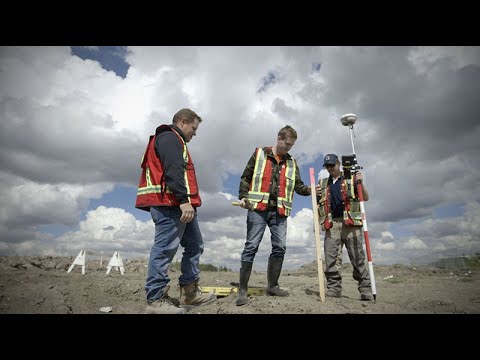Career Overview
Land surveyors plan, direct and carry out legal surveys to establish the location of real property boundaries, contours and other natural or human-made features. They also prepare and maintain cross-sectional drawings, official plans, records and documents pertaining to legal surveys.
Land surveyors may be self-employed or work for:
- Federal, provincial and municipal governments
- Private sector land surveying companies
- Real estate development firms
- Natural resource companies
- Engineering firms
- Construction companies
Job Titles
Duties
Land surveyors perform some or all of the following duties:
- Develop survey plans, methods and procedures for conducting legal surveys
- Plan, direct and oversee surveys to establish and mark legal boundaries of properties, parcels of lands, provincial and Canada Lands, aboriginal land claims, well-sites, mining claims, utility rights-of-way, roadways and highways
- Survey and lay out subdivisions for rural and urban development
- Determine exact locations using electronic distance measuring equipment and global positioning systems (GPS)
- Analyze, manage and display data using geographic information systems (GIS) and computer-aided design and drafting (CAD)
- Record all measurements and other information obtained during survey activities
- Prepare or oversee the preparation and compilation of all data, plans, charts, records and documents related to surveys of real property boundaries
- Approve and be responsible for surveys made to establish real property boundaries
- Advise, provide consultation and testify as an expert witness on matters related to legal surveys
Earnings
Earnings is income that workers receive in exchange for their labour. Depending on the type of employment, earnings can be in the form of wages (hourly), salaries (fixed monthly or annual) or self-employed earnings.
Work Environment
# Workers Employed
1,050% Employed Full Time
70%Work in this occupation is typically performed in a structured environment, such as an office, or an outdoor work environment where the worker is exposed to various weather conditions.
Career Pathways
Federal statutes require a separate license from the Association of Canada Land Surveyors to survey areas such as national parks, aboriginal lands, offshore areas and northern territories.
Occupational Interests
It’s important to understand what kinds of occupations align with your interests.
For more about occupational interests visit Skills for the Future Workforce > Characteristics.
Here are the top occupational interest(s) for this career profile:
Education, Training and Skills
- A bachelor's degree in geomatics engineering or survey engineering
or
A college diploma in survey science or geomatics technology with additional academic credits and successful completion of equivalent examinations set by a regional board of examiners for land surveyors is required - A one- to three-year articling period is required
- Successful completion of professional land surveyor examinations is required
- A federal or provincial land surveyor's licence is required
Land surveyors who are certified for that occupation by a regulator elsewhere in Canada can apply for the same certification from the regulator in B.C. Under the terms of the Canadian Free Trade Agreement (CFTA), most applicants who are transferring their credentials from elsewhere in Canada will not be required to complete additional training or testing. However, the B.C. regulator may ask applicants to provide further information such as a letter of good standing, references, or criminal record check.
For those who trained outside of Canada and never received certification from any Canadian jurisdiction, a full assessment is likely needed. Most occupational regulators have a process for assessment and recognize internationally trained applicants.
Contact the Association of BC Land Surveyors for details on how to apply for certification in B.C.
For information about labour mobility in Canada, visit www.workersmobility.ca.
View a list of Professional Regulatory Authorities in B.C.
Education programs in B.C.

Top Skills
Every job calls for a certain set of skills. Knowing those skills is the first step in finding a good career fit.
Here, you will find the 10 most relevant workplace skills. Some are more important to achieving success in a certain career than others. These skills may come naturally to you or you may need to gain them through education, training and experience.
See the list of work-related skills below, ranked in order of importance for this career. Check out the list and see if this career matches your skills—take that first step!
Using mathematics to solve problems.
Understanding written sentences and paragraphs in work-related documents.
Using logic and reasoning to identify the strengths and weaknesses of alternative solutions, conclusions or approaches to problems.
Giving full attention to what other people are saying, taking time to understand the points being made, asking questions as appropriate, and not interrupting at inappropriate times.
Communicating effectively in writing as appropriate for the needs of the audience.
Talking to others to share information effectively.
Being able to solve novel, ill-defined problems in complex, real-world settings.
Considering the relative costs and benefits of potential actions to choose the most appropriate one.
Understanding how new information could be used to solve current and future problems in making decisions.
Adjusting actions in relation to others' actions.
Labour Market Statistics
Discover data, facts and information that have been gathered and analyzed. Learn about the characteristics of the economy and labour market in B.C.
Employment
Find out about employment types and trends by region and industry.
Employment
1,050Employment by Region







| Region | Employment | % Employment of this Occupation |
|---|---|---|
| Cariboo | 35 | 3.3% |
| Kootenay | 30 | 2.9% |
| Mainland/Southwest | 510 | 48.6% |
| North Coast and Nechako | 25 | 2.4% |
| Northeast | 55 | 5.2% |
| Thompson-Okanagan | 175 | 16.7% |
| Vancouver Island/Coast | 215 | 20.5% |
Labour Market Outlook
The B.C. Labour Market Outlook is a 10-year forecast of the expected supply and demand for labour in the province. It’s usually updated every year. The purpose is to provide British Columbians with the knowledge to make informed decisions on careers, skills training, education and hiring.
Forecasted Job Openings (2025-2035)
470Forecasted Job Openings
Forecasted Employment Growth Rate
Composition of Job Openings
Job Openings by Region (2025-2035)







| Region | Job Openings | Avg. Annual Employment Growth |
|---|---|---|
| Cariboo | 0 | -1.1% |
| Kootenay | 10 | 0.6% |
| Mainland/Southwest | 210 | 1.5% |
| North Coast and Nechako | 10 | 0.6% |
| Northeast | 20 | 0.7% |
| Thompson-Okanagan | 80 | 0.8% |
| Vancouver Island/Coast | 140 | 2.0% |
Industry Highlights
Learn about the opportunities in B.C.'s major industries, including employment trends, earning potential, locations of work and more.
Forecasted Job Openings by Industry
| Industry | Job Openings (2025-2035) |
|---|---|
| Professional, Scientific and Technical Services | 370 |
| Construction | 60 |
| Public Administration | 20 |
| Mining and Oil and Gas Extraction | 10 |
Resources
-
Association of British Columbia Land Surveyors – Employment Opportunitieswww.abcls.ca/?page_id=31
-
Canadian Institute of Geomatics (CIG)www.cig-acsg.ca
-
Professional Surveyors Canadawww.psc-gpc.ca








